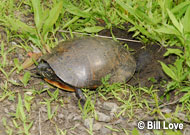Description:
Eastern painted turtles are perhaps one of the most attractive North American turtles. Their small size and generally pleasant disposition make them a good choice for the home aquarium. Painted turtles are quite long-lived, perhaps reaching 60 years or more in the wild, so keep that in mind when you take on the responsibility of caring for one. Eastern painted turtles are fond of basking and require a platform or sloping log where they can get their entire bodies out of the water. A basking light that provides a temperature of approximately 80 degrees Fahrenheit will be a necessity. Plastic grating or egg crate material provides a good basking platform, as the plastic will not be abrasive to the turtle’s plastron, and the grating will allow the plastron to dry, reducing the chances of shell fungus and rot. Eastern painted turtles are omnivorous and will eat aquatic plants such as elodea. They will get very excited about earthworms, crickets and other insects. They must swallow their food underwater. Turtle pellets are readily consumed in captivity. Filtered water in an aquarium setting will help keep eastern painted turtles healthy.
Habitat:
Eastern painted turtles are common inhabitants of permanent ponds, the weed-choked shallow coves of large northern lakes, beaver ponds and farm ponds. They occasionally occur in the slow-moving sections of rivers.
Range:
The eastern painted turtle is one of four recognized subspecies. The eastern race is found from Maine southward along the northeast coast to North Carolina, and then farther south it occurs inland in South Carolina and Georgia. It generally occurs east of the Appalachian Mountains.
Scientific Name: Chrysemys picta picta
Species Group: turtle
Family: Emydidae
Size: 4½ to 6 inches
Level: beginner
Weight: N/A
Dangerous: No


